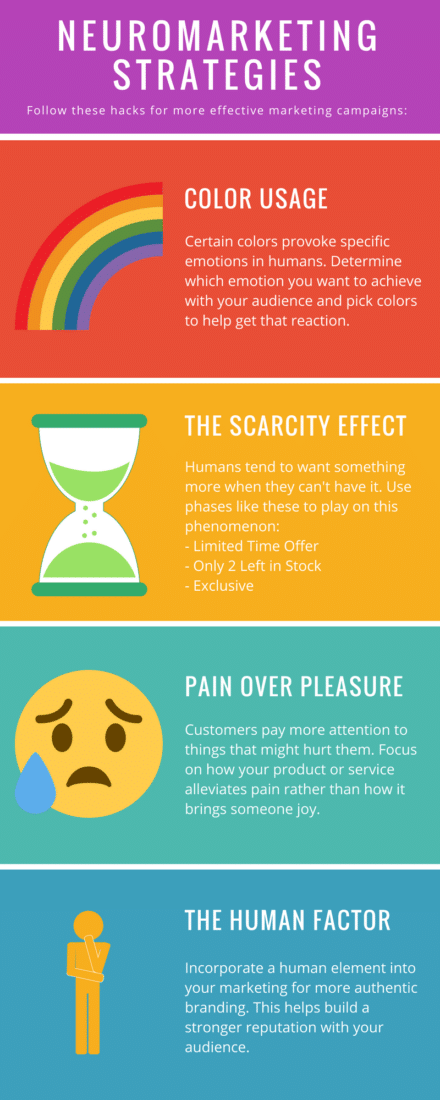It’s every marketer’s dream to fully understand why a consumer responds the way they do—to get inside their heads. Fortunately science is revealing there may be a way, and it’s gaining more traction as a viable marketing tool for truly understanding consumer behavior. There are countless benefits to neuromarketing.
Neuroscience is the study of “how the nervous system develops, its structure, and what it does.” It examines why people think, feel, and act the way they do. The application of neuroscience and marketing combines both the understanding the human brain and human behavior, which is the practice of neuromarketing.
Brain Waves
Neuromarketing studies the brain to understand consumer behavior and decision making. It measures physiological and neural signals to gather insight into customers’ motivations, preferences and decisions. Some common methods to access these insights are brain scanning, which measures neural activity, and physiological tracking, which measures eye movement.

Information Offloading
On a daily basis, people are bombarded with 3,000 to 5,000 marketing messages. This results in information overload, putting a tremendous strain on the brain to figure out what to pay attention to and what to ignore. Information overload causes brains to shut down and dismiss much of what’s coming at them.
In order to connect and engage deeply with customers, you need to understand why they think the way they do. This connection enables you to properly communicate with them and ultimately lead them to action. Neuromarketing, in turn, allows a brand to develop more valued relationships over time.
To cut through the noise, brands must capture the attention of their audience. “We humans think of ourselves as rational creatures who make choices based on a conscious and logical thought process,” wrote David Wharram, CEO of Coast Digital, in a guest piece for Velocitize. “But neuroscience tells us that in truth we make a lot of our decisions based on intuition; that ‘gut feeling’ of ours.”
Ninety to 95 percent of purchase decisions are made by the subconscious mind (Nielsen and Harvard Business School). If a brand is not evoking an emotional response from their audience, then they’re making it mentally and physically challenging for them to buy their products and services. Google and CEB conducted a study of B2B firms and found that emotional messaging has twice the impact as non-emotional messaging, and that purchase intent declines if emotional messaging is reduced during the purchase cycle.

Neuromarketing Insights
The benefits of neuromarketing include gaining insight into messaging that resonates with the consumer. Studying your target audience’s reaction and response to your brand provides insight into what stimulates them and what turns them off. Sensory overload leads to frustration and will connect your brand with negative feelings.
Neuromarketing can deliver improvement and assess effectiveness on the following marketing strategies:
- Advertising creative: traditional, digital and mobile
- Brand logos, package design and color schemes
- Website design
- In-store placement of products, consumer experience in store and shopping behavior
- Product design
- Brand tracking
- Promotional campaign
- User Experience Design (UXD)
When designing your site, Hick’s Law suggests that the more choices a user is given visually, the longer it takes to make a decision. This eventually leads to the user becoming annoyed or confused and most likely leaving the website. Every digital design needs to consider reducing cognitive load. Designers analyze how to make these choices easier for users, thereby enabling a pleasant user experience on the website.
Another way to grab consumers’ attention is through deviation from the norm or surprise. According to studies by neuroscientist Gregory Berns, the human brain is programmed to enjoy surprise. As our brains are constantly inundated with input, your brand will have more success by going against the grain. Surprise your audience with the unexpected.
Many companies have already invested in neuromarketing with much success. NBC and TimeWarner have operated neuromarketing teams for years; technology companies Microsoft, Google, and Facebook have also invested heavily in neuromarketing.

Neuromarketing Research
A series of academic studies have demonstrated that brain data can predict the future success of products more accurately than traditional market research tools, such as surveys and focus groups.
Traditional market research approaches have human flaws. For example, people can’t always recall their memories, feelings and preferences. They also can lie when trying to please, or are embarrassed, and their perceptions can be influenced by how a question is asked. “What comes out of our mouths is not always a perfect rendition of what’s going on in our brains,” said Michael Platt, director of the Wharton Neuroscience Initiative.
Biometrics is a research measurement of human behavior. It gives marketers the ability to understand not only what users say about what they see, but how it makes them feel. “What should be particularly exciting to marketers is the possibility that only a small number of people may be able to [accurately] predict how a large customer base will respond,” says Uma Karmarkar, a neuroeconomist at UC San Diego.
According to the Advertising Research Foundation, “the strength of neuromarketing and biometric methods lies in their ability to uncover responses to advertising better than many other methods. Also, as they usually provide moment-by-moment data on changes in viewer reactions, they are well-suited to diagnose and improve marketing communication in a more detailed manner.”

Neuromarketing Best Practices
Here are some questions to answer before implementing neuroscience into your marketing research:
- What needs to be measured and what are your business objectives? Be clear before you decide which methods to use. Sometimes eye tracking (one of the least expensive methods) may be sufficient. At other times, a much more complex study using several measures is essential to obtain the desired information.
- What are the pros and cons of various biometric and neuro-based methods?
- How do the various methods measure different things (for example, different kinds of “attention”)? What exactly can these methods measure and to what extent emotions or other reactions are inferred rather than actually measured?
- Are actual neuroscientists involved in the study?
- Are any of the consultancy’s methods, data or tools published in peer-reviewed journals?
- Is the subject pool representative (a question that is particularly important for global brands)?
- Do the consultants have marketing expertise along with scientific knowledge?
- Do they have a track record of success?
- Can they prove that they will offer insights beyond what can be gleaned through traditional methods?
Some things to remember when you are conducting a neuromarketing study:
- Use biometric and neuro-based methods early in the creative development process. Include creative agencies in the process.
- Data requires interpretation and should be reviewed alongside traditional testing data. Include the creative agency in the review of the data.
- Predictive power of the measures and the conclusions improves when several neurological and traditional measures are combined.
Source: Advertising Research Foundation and Harvard Business Review

In the end, neuromarketing is a tool to assist marketers overcome some of the barriers in traditional market research, like getting beneath surface emotions to the subconscious and measuring emotional markers in real time instead of during recall. Neuromarketing allows deep insight into the consumer’s brain and is a valuable way to supplement traditional marketing research methods.
Image by Gerd Altmann from Pixabay





Join the conversation